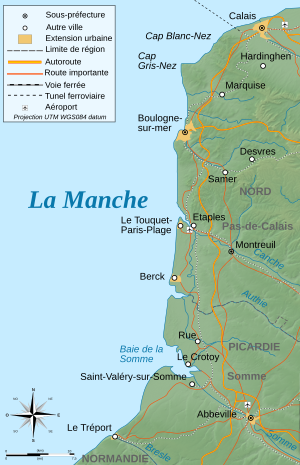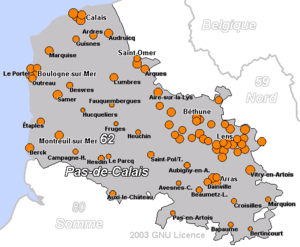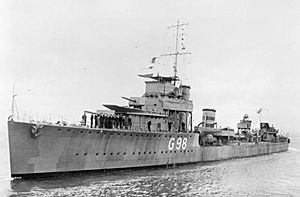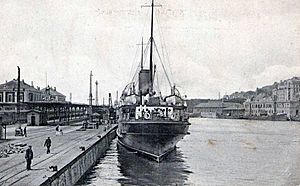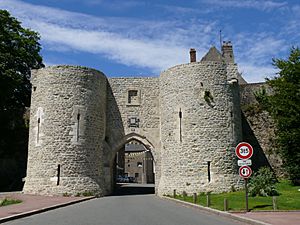Battle of Boulogne facts for kids
Quick facts for kids Battle of Boulogne (1940) |
|||||||
|---|---|---|---|---|---|---|---|
| Part of Battle of France | |||||||
 The Battle of France, situation 21 May – 4 June 1940 |
|||||||
|
|||||||
| Belligerents | |||||||
| Commanders and leaders | |||||||
| Strength | |||||||
1,500 Auxiliary Military Pioneer Corps troops supporting units |
1 panzer division | ||||||
| Casualties and losses | |||||||
| c. 5,000 POW | |||||||
The Battle of Boulogne was a fight during World War II in May 1940. It happened in the port city of Boulogne-sur-Mer, France. French, British, and Belgian soldiers defended the city against German forces.
This battle took place at the same time as the Siege of Calais. Both battles happened just before Operation Dynamo. Operation Dynamo was the famous evacuation of Allied soldiers from Dunkirk.
After a counter-attack by Allied forces at Arras on May 21, German tanks moved quickly. General Heinz Guderian wanted to capture the Channel ports like Boulogne. On May 22, German tanks attacked Boulogne. British troops, including the 20th Guards Brigade, had just arrived. They quickly dug in to defend the port.
The battle lasted several days. Royal Navy ships helped by firing at German positions. They also evacuated wounded soldiers and other people. The French and remaining British troops fought hard. However, they were eventually surrounded and had to surrender on May 25.
Contents
The Battle for Boulogne
Why Boulogne Was Important
Boulogne-sur-Mer is a port city in France. It is located on the English Channel. Other important Channel ports nearby include Calais and Dunkirk. Boulogne is at the mouth of the River Liane. The city has a harbor on flat ground. Behind it are steep roads leading to the old town, called the Citadel.
The hills around Boulogne offer good views for attackers. They can see into the port from high ground. During the early part of World War II, called the Phoney War, British troops used ports further west for supplies. But later, the Channel ports became important. They were used for supplies and for soldiers traveling on leave.
Germany's Plan
On May 10, 1940, Germany launched its attack on France, Belgium, and the Netherlands. This was called Fall Gelb (Case Yellow). German forces quickly broke through the French defenses. They drove west towards the River Somme.
As the British Expeditionary Force (BEF) moved back, their supply lines became shorter. They started sending extra soldiers home through Boulogne and Calais. On May 21, German troops captured Abbeville. This cut off the Allied forces in northern France and Belgium. The Channel ports became the only way for Allied troops to get supplies or escape.
The French Navy was in charge of defending Boulogne. They had about 1,100 men in the city's old forts. British anti-aircraft guns and machine-guns also arrived. The French had some field guns and anti-tank guns. On May 20, German tanks reached Abbeville. The French naval commander ordered his men to retreat to the old town. He also told them to disable their coastal guns.
Some French officers left the city, causing confusion. But other officers, like Capitaine Poher, tried to keep order. Later, Admiral Marcel Leclerc ordered the sailors to fight. He told them to defend the town and wait for help.
Getting Ready to Fight
On May 21, a small group of Royal Marines arrived in Boulogne. The next morning, the British 20th Guards Brigade arrived. This brigade included the 2nd Battalion, Welsh Guards and 2nd Battalion, Irish Guards. They also had anti-tank guns.
The Guards set up their defenses on the high ground outside the city. The Irish Guards defended the southern part. The Welsh Guards defended the northern part. They created a defensive line about 6 miles (10 km) long. Roadblocks were set up by other British troops. About 1,500 men from the Auxiliary Military Pioneer Corps (AMPC) were also in the town. These men were mostly laborers waiting to be evacuated.
The French 21st Infantry Division was supposed to hold a line south of Boulogne. However, many of these French troops were ambushed by German tanks. This meant they could not reach Boulogne to help.
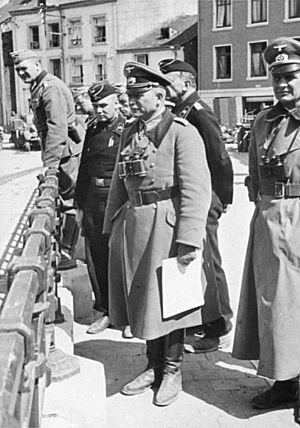
The German plan was to capture Boulogne and Calais. The 2nd Panzer Division was ordered to advance towards Boulogne. Another division, the 1st Panzer Division, protected their side. This was to prevent any counter-attacks from Calais.
Fighting Begins: May 22
The 2nd Panzer Division split into two groups. One group attacked from the north. The other attacked from the south. The southern group met French troops first. These French soldiers, mostly clerks and drivers, fought bravely. They used two field guns and two anti-tank guns. They held up the Germans for almost two hours.
In the evening, German tanks reached the edge of Boulogne. They started shelling the Irish Guards' positions. The Irish Guards destroyed one German tank. They fought off several attacks. In the early morning, Germans attacked the Welsh Guards from the north-east. But they were pushed back each time.
The British General Douglas Brownrigg left Boulogne early on May 23. He took his staff on a destroyer without telling the Guards. This left the Guards without their main way to talk to England.
Intense Fighting and Evacuation: May 23
After dawn, German troops captured a fort north of Boulogne. British reinforcements from Calais could not arrive. This was because German tanks appeared at the northern edge of the city. Brigadier William Fox-Pitt realized he had to defend Boulogne with fewer troops.
The AMPC men were quickly given rifles. About 800 of them were sent to fill a gap in the British defenses. Another 150 helped the Welsh Guards. Anti-aircraft gunners destroyed two German tanks.
The Germans began attacking the Welsh and Irish Guards from both sides. By 10:00 a.m., the British were forced back into the town. German planes, called Stukas, bombed the city's defenses. This helped the German ground troops.
At noon, the destroyer HMS Vimy arrived. It brought a team to destroy port facilities. It also started evacuating wounded soldiers and the AMPC. Fox-Pitt received orders to hold Boulogne at all costs. His radio contact with England was gone.
Royal Navy and French destroyers provided fire support. They fired their guns at German positions. The commander of the 2nd Panzer Division noted that the British and French were "fighting tenaciously." He wasn't sure if the British were leaving or getting more troops.
In the afternoon, another destroyer, HMS Keith, arrived. It began taking on AMPC troops. German planes attacked the harbor. British Royal Air Force (RAF) Spitfires fought them off. But the commanders of two British destroyers were killed by bomb fragments. Several French destroyers were also damaged or sunk.
By 3:00 p.m., Fox-Pitt pulled his troops back into the town. He moved his headquarters closer to the quay. This was to better communicate with the destroyers. He sent a message to London saying the "situation grave."
Shortly before 6:00 p.m., Keith received orders to evacuate all British troops immediately. Fox-Pitt decided to continue evacuating the AMPC. The Guards would fight their way back to the harbor. Royal Engineers blew up bridges. The Irish Guards blocked streets with vehicles.
Other destroyers, Vimiera and Whitshed, replaced the first ships. They took on more Marines and Guards. German artillery fired at the harbor. But the destroyers, like HMS Venomous, fired back. They even knocked out German tanks. Despite heavy fire, the destroyers managed to leave the harbor.
Final Resistance and Surrender: May 24–25
The destroyer HMS Windsor arrived after dark. It continued the evacuation. The captain of Windsor signaled that more British troops needed to be evacuated. So, Vimiera returned to Boulogne at 1:30 a.m. The quay seemed empty. But when the captain called out, many men appeared from hiding. The crew managed to get them all aboard. When Vimiera reached Dover, 1,400 men disembarked.
Most British troops had left. But about 300 Welsh Guards remained. They had lost contact and were cut off from the docks. They split into smaller groups and tried to escape. General Pierre Louis Félix Lanquetot was in the old town. He organized the French defense as best he could.
German attacks on the town on May 24 were pushed back. Some German tanks were destroyed. The French Navy continued to help with gunfire. But two French destroyers were damaged by German planes. One was sunk the next day.
During the night, about 100 French soldiers tried to break out. But they failed. At dawn on May 25, the Germans attacked again. They used grenades and flamethrowers. They also had powerful 88 mm guns. At 8:30 a.m., General Lanquetot surrendered. German planes continued to bomb the town.
The last British unit was 3 Company, Welsh Guards. They reached the docks at daybreak, but Vimiera had already left. Major Windsor Lewis took charge of a group of soldiers and civilians. They were hiding in sheds at the quay. They moved to the harbor railway station. They built barricades with sandbags.
On the evening of May 24, they fought off a German group. The Germans approached the quay in a boat. The British and French soldiers had no food and little ammunition. There was no hope of being evacuated. So, the force surrendered at 1:00 p.m. on May 25. The Germans captured about 5,000 Allied troops in Boulogne. Most of them were French. Many prisoners were made to repair the harbor defenses.
Troops Evacuated
| Ship | Troops |
|---|---|
| Keith | 180 |
| Vimy | 150 |
| Whitshed | 580 |
| Vimiera | 1,955 |
| Wild Swan | 400 |
| Windsor | 600 |
| Venomous | 500 |
| Total | 4,365 |
See also
- Boulogne Bowl, a commemorative silver trophy in recognition of the role of the Pioneer Corps in the 1940 Battle of Boulogne
- Operation Wellhit, the Canadian liberation of Boulogne in 1944
- List of British military equipment of World War II
- List of French military equipment of World War II
- List of Belgian military equipment of World War II
- List of German military equipment of World War II


